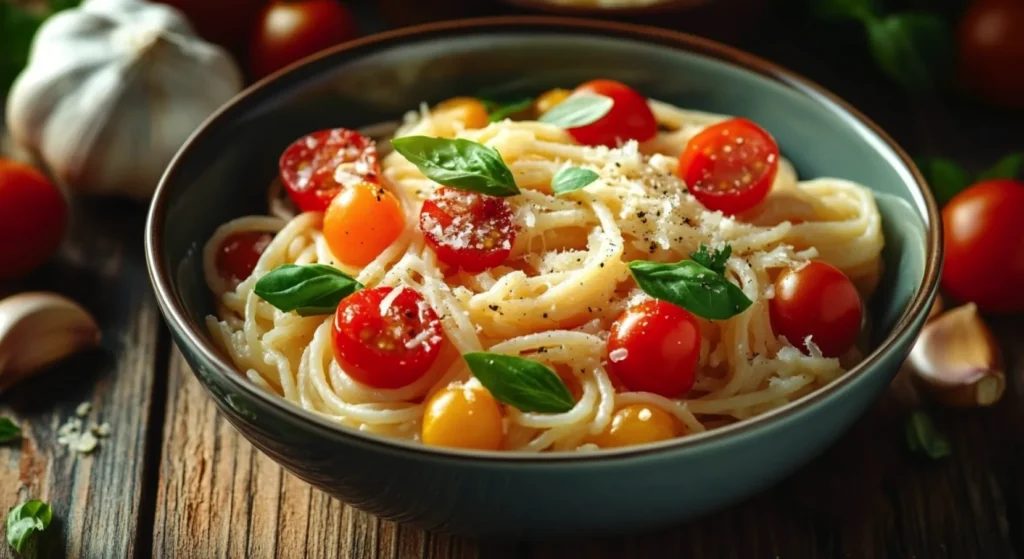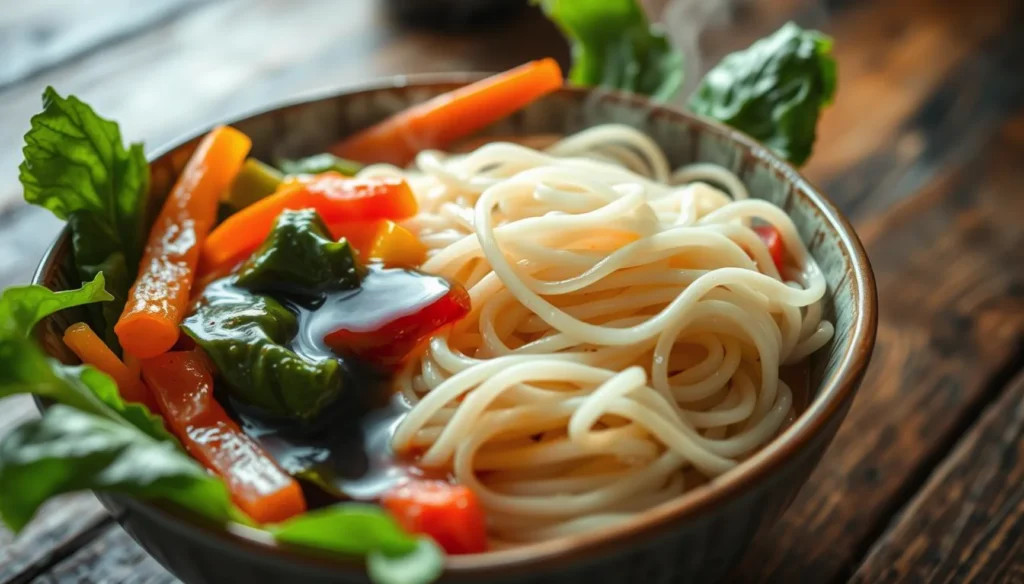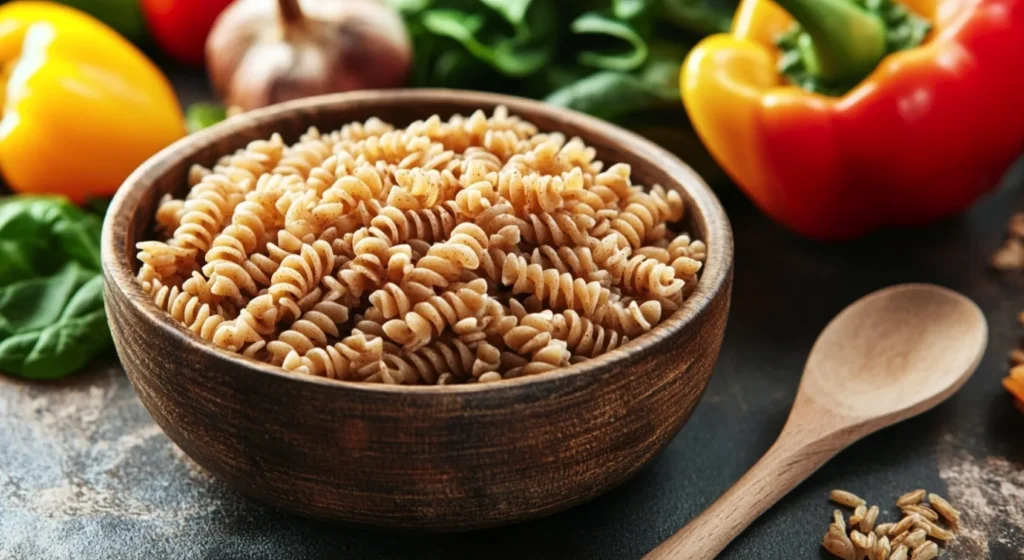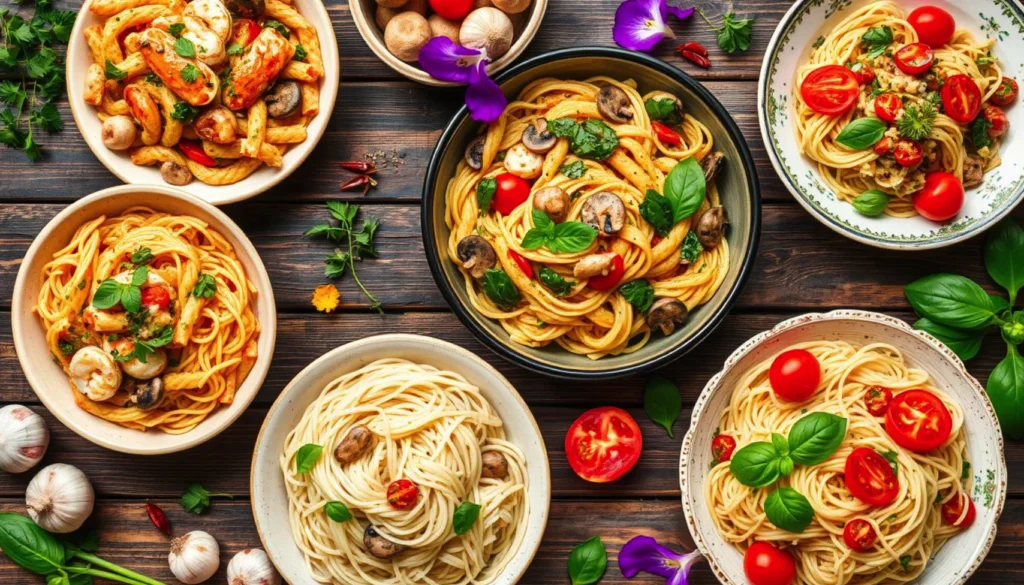I’ve struggled with gluten sensitivities for years. Finding good, healthy meals was hard. But then I found rice pasta. It’s changed my meals and opened up new cooking ideas.
Rice pasta is not just an alternative to regular pasta; it’s a game-changer in the world of cooking. With its unique texture and delicate, mild flavor, rice pasta adds a distinctive touch to any dish, effortlessly elevating both simple weeknight meals and gourmet creations. Whether you’re preparing a light pasta salad, a hearty casserole, or a classic spaghetti dish, rice pasta adapts beautifully, enhancing the overall culinary experience.
For those with gluten sensitivities, celiac disease, or anyone exploring healthier food choices, rice pasta is a versatile and delicious solution. It allows individuals to enjoy their favorite pasta dishes without compromising on taste or texture. Moreover, it appeals to adventurous cooks and food enthusiasts eager to try something new and expand their repertoire with a gluten-free option that’s as satisfying as it is nutritious.
This guide dives deep into the world of rice pasta, covering everything you need to know to make it a staple in your kitchen. We’ll explore its numerous health benefits, share foolproof cooking tips to achieve perfect results every time, and provide a variety of recipes to suit any occasion. From quick, family-friendly meals to sophisticated dinner party fare, rice pasta has the versatility and nutritional value to be a key ingredient in your cooking. Whether you’re a seasoned chef or a beginner in the kitchen, this guide will inspire you to embrace rice pasta as a delicious, healthy, and gluten-free alternative.
Table of contents
Understanding Rice Pasta and Its Nutritional Benefits

A rice pasta, elegantly twirled and topped with fresh basil, cherry tomatoes, and a drizzle of olive oil.
Rice-based pasta opens up a world of nutritional possibilities, making it a standout option for anyone seeking healthier, gluten-free alternatives to traditional wheat pasta. Unlike wheat pasta, rice pasta is entirely grain-free, making it a safe and satisfying choice for individuals with celiac disease or gluten sensitivities. Its unique composition not only eliminates gluten but also offers a different texture and flavor profile that adds variety to meals.
What sets rice pasta apart is its nutritional richness. It serves as an excellent source of complex carbohydrates, providing steady energy without the gluten-related issues associated with wheat. Additionally, rice pasta is often enriched with essential nutrients like B vitamins, iron, and magnesium, contributing to overall health and well-being. It’s also high in fiber, which supports healthy digestion and helps regulate blood sugar levels.
When compared to wheat pasta, rice pasta often boasts lower calorie and fat content, making it a desirable choice for weight-conscious individuals or those seeking a lighter option. Its versatility and nutritional benefits make rice pasta not just an alternative, but a valuable addition to a variety of diets, whether gluten-free, vegan, or simply focused on better health.
Essential Nutrients in Rice-Based Pasta
Rice pasta is a nutritional powerhouse, offering more than just a gluten-free alternative to traditional pasta. It is rich in complex carbohydrates, which serve as a reliable source of steady energy, making it an excellent choice for maintaining stamina throughout the day. These carbohydrates are slowly digested, helping to avoid energy spikes and crashes, which is especially beneficial for active lifestyles and those managing their blood sugar levels.
Beyond its carbohydrate content, rice pasta boasts a high fiber content, essential for supporting healthy digestion and promoting gut health. Fiber helps regulate bowel movements, reduces the risk of digestive issues, and plays a vital role in blood sugar control by slowing the absorption of sugars into the bloodstream. This makes rice pasta an excellent choice for individuals looking to manage diabetes or maintain a balanced diet.
Moreover, rice pasta is packed with essential vitamins and minerals that contribute to overall health and well-being. It contains B vitamins, which are crucial for energy production, brain function, and red blood cell formation. It is also a good source of iron, important for preventing anemia and supporting oxygen transport in the body, and magnesium, which aids in muscle function, bone health, and maintaining a steady heart rhythm.
Incorporating rice pasta into your meals provides not only a versatile and delicious base for countless dishes but also a nutrient-rich addition to a healthy diet. Whether you’re seeking sustained energy, improved digestion, or a boost in essential nutrients, rice pasta offers a wholesome and satisfying option.
Comparing Rice Pasta to Traditional Wheat Pasta
Rice pasta beats wheat pasta in many ways. It has fewer calories and less fat. This is great for those watching their calories or eating gluten-free. Rice noodles are also naturally free of gluten, making them safe for those with celiac disease or gluten sensitivities.
Health Benefits for Different Dietary Needs
- Gluten-free: Rice pasta is perfect for a gluten-free diet, offering a tasty and safe pasta choice.
- Vegan: Rice noodles are great for vegan and vegetarian diets, providing a nutritious pasta option.
- Weight management: Rice pasta’s low calorie and fat content is ideal for those trying to manage their weight and live a healthy lifestyle.
Choosing rice-based pasta can change your eating habits for the better. It’s perfect for those with dietary restrictions or just looking for new pasta options. Rice noodles offer great taste and nutrition.

A rice noodles, surrounded by fresh vegetables like bell peppers, carrots, and bok choy, with a delicate drizzle of soy sauce.
How to Cook Perfect alternative pasta Every Time
Cooking alternative pasta to perfection is a big win in the kitchen. With the right steps, you can get the perfect texture and taste every time. These tips will help you cook rice pasta like a pro, whether you’re new or experienced.
Achieving the Perfect Al Dente Texture
The secret to cooking alternative pasta, is not to overcook it. Follow these steps for the perfect al dente texture:
- Bring a large pot of salted water to a rolling boil.
- Add the rice pasta and stir gently to prevent sticking.
- Cook the pasta according to the package instructions, typically 8-12 minutes.
- Test the pasta for doneness by biting into a piece. It should have a slightly firm, chewy center.
- Drain the rice pasta immediately and rinse with cold water to stop the cooking process.
Preventing Sticking and Clumping
One common problem with rice pasta is it sticking together or clumping. Here’s how to avoid this:
- Use a large pot with plenty of water to allow the pasta to move freely.
- Add a teaspoon of oil to the boiling water to help keep the rice pasta separated.
- Stir the pasta frequently during cooking to prevent it from sticking to the pot or to itself.
- Drain the rice pasta immediately and rinse with cold water to cool it down and prevent further sticking.

By following these simple cooking techniques, you’ll be able to prepare rice pasta that is perfectly cooked and ready to be transformed into a delicious meal.
Versatile Rice Pasta Recipes for Any Occasion
Rice pasta is more than just a gluten-free option. It’s a blank canvas for delicious dishes for any event. Whether you need fast weeknight meals, fancy dishes, or something kids will love, rice pasta is perfect.
Quick and Easy Weeknight Dishes
Weeknights can be busy, and cooking should be quick. Rice pasta dishes are fast to make and full of flavor. Try a simple rice pasta with sautéed veggies and olive oil for a tasty, vegan meal. Or, mix allergen-free pasta with creamy pesto and grilled chicken for a filling dinner.
Gourmet Rice Pasta Creations
Choosing rice pasta doesn’t mean you can’t enjoy fancy meals. Make a rich rice pasta carbonara with crispy pancetta and egg sauce. Or, try a vegetarian rice pasta baked ziti with creamy ricotta and tomato sauce.
Kid-Friendly Rice Pasta Meals
Getting kids to eat can be tough, but rice pasta helps. They’ll love a classic rice pasta mac and cheese or a fun twist on spaghetti and meatballs. Let them help make a colorful rice pasta primavera with their favorite veggies.

A variety of rice pasta dishes.
“The beauty of rice pasta is its ability to adapt to any culinary style or preference. From quick weeknight meals to gourmet feasts, the possibilities are endless.”
Choosing the Best Rice Pasta Brands and Types
Finding the right rice pasta can be tough. There’s everything from white rice pasta to quinoa blends. I’ve helped you find the best rice pasta brands and types for your needs.
Quality ingredients are key when picking rice pasta. Choose brands with no additives or preservatives. Look for organic and non-GMO options for healthier choices. Also, try pasta with quinoa for more nutrients.
- Look for rice pasta brands that use high-quality, minimally processed ingredients.
- Consider organic and non-GMO options for a healthier alternative to traditional wheat pasta.
- Experiment with rice pasta blends that combine rice with other whole grains like quinoa for added nutrition.
Check the cooking instructions on labels. Some rice pasta needs different cooking methods. Follow the maker’s advice for perfect texture every time.
“The beauty of rice pasta is that it allows me to enjoy all the classic pasta dishes I love, but in a gluten-free and more nutritious form.”
There are many great rice pasta brands, quinoa pasta, and alternative pasta choices. Focus on quality, nutrients, and cooking tips. This way, you can make tasty, guilt-free meals for everyone.
Conclusion
Rice pasta is a great gluten-free choice. It’s full of nutrients and can be used in many ways. It’s perfect for those looking for a healthier pasta option or for special diets.
You now know about the good stuff in rice pasta. It’s better than regular pasta in many ways. It’s great for people with gluten-free diets and helps with health goals.
Try making rice pasta dishes at home. You can make quick meals, fancy dishes, or even food kids will love. Rice pasta is tasty, healthy, and very flexible. It’s the best choice for any meal.
FAQ
What is rice pasta?
Rice pasta is a gluten-free pasta made from rice flour. It’s a healthy choice for many diets.
How does rice pasta compare to regular pasta in terms of nutrition?
Rice pasta has more fiber and fewer calories than regular pasta. It’s also gluten-free, good for those with gluten issues.
What are the health benefits of incorporating rice pasta into my diet?
Rice pasta is full of complex carbs for steady energy. It’s great for gluten-free, vegan, or allergen-free diets. It’s also good for diabetes and weight management.
How do I cook rice pasta to achieve the perfect texture?
Boil salted water in a big pot. Add pasta and follow package instructions. Stir often to avoid sticking. Cook a minute or two less for al dente.
What are some delicious and easy-to-make rice pasta recipes?
Try creamy mushroom carbonara, Mediterranean pasta salad, or kid-friendly mac and cheese. These are tasty and easy to make.
How do I choose the best rice pasta brands and varieties?
Look for brands with quality ingredients and no additives. Try different types like brown rice or quinoa pasta to find what you like.
For more great recipes please click here.

